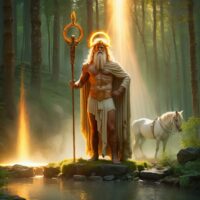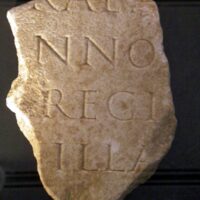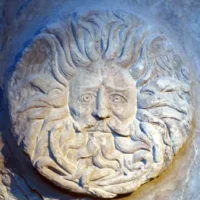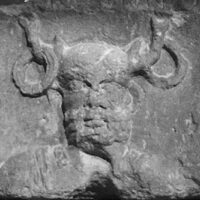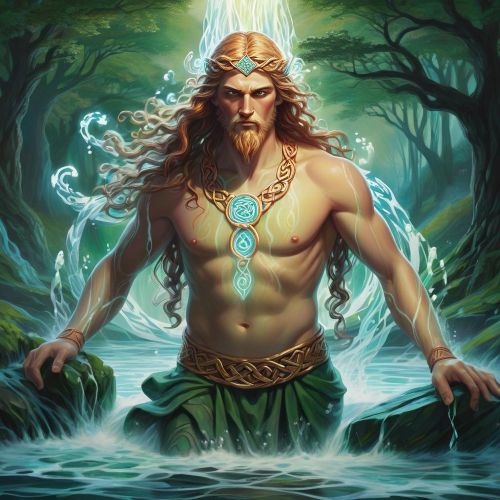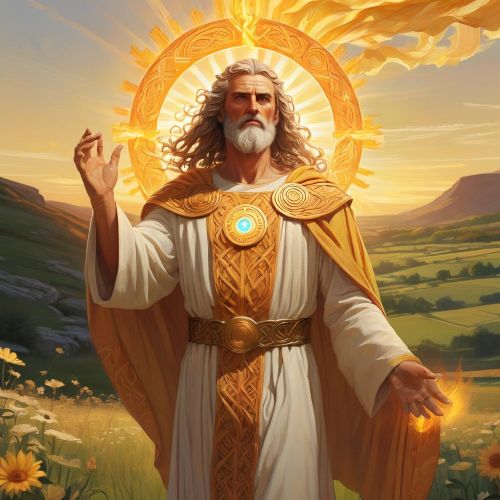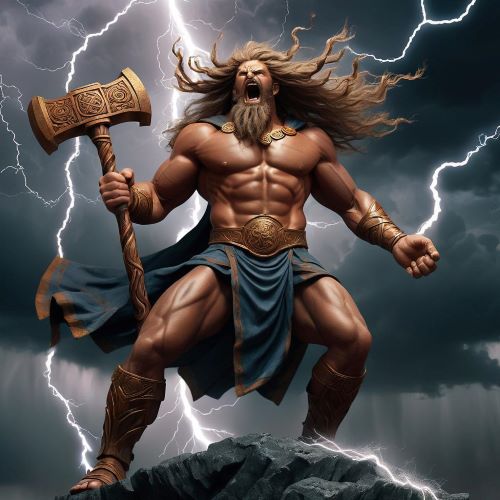Grannus : God of Healing
Listen
At a glance
| Description | |
|---|---|
| Origin | Gaulish Mythology |
| Classification | Gods |
| Family Members | Sirona |
| Region | France |
| Associated With | Healing, Light, Sun |
Grannus
Introduction
Grannus, one of the central deities of Gaulish mythology, stood out as a god of healing and sunlight, deeply connected to thermal springs and the life-affirming forces of nature. His veneration was widespread across ancient Gaul, especially in regions that today span parts of France, Germany, and Belgium. Most notably, his presence is felt at Aquae Granni, the Roman name for what is now Aachen, Germany. Grannus’ significance increased with the Roman occupation of Celtic lands, as he was syncretized with Apollo, resulting in the figure of Apollo Grannus—blending local beliefs with Roman religious structure. This hybrid identity not only reinforced his importance in healing rituals but also helped preserve his legacy through Roman texts and archaeological remains.
Physical Traits
Although there are no universally recognized statues or surviving images of Grannus, historical interpretations often envision him as a youthful, radiant figure closely aligned with solar imagery. Descriptions of a solar halo or a chariot drawn by horses capture his elemental connection to the sun, vitality, and life force. The symbolism of warmth and light reinforces his divine identity as a source of both physical healing and spiritual renewal. Linguistic evidence hints that his name might derive from the Proto-Celtic root gwrīns- or gran- meaning “heat” or “glow,” further affirming his solar character. Despite alternate etymologies suggesting connections to age or a bearded visage, most modern interpretations depict Grannus as eternally youthful—an embodiment of rejuvenation.
Family
Grannus is most frequently associated with Sirona, a Gaulish goddess tied to healing waters and often found in inscriptions and dedications alongside him. Their divine pairing presents a balanced duality—Grannus representing light and solar energy, and Sirona symbolizing the nurturing and restorative aspects of water. This mythological partnership serves to emphasize the holistic nature of ancient healing practices, where both celestial and terrestrial forces worked together. In Roman adaptations, Grannus’ assimilation into Apollo’s identity widened his divine family to include members such as Diana, Æsculapius, and Latona, echoing Apollo’s expansive mythos while maintaining Grannus’ unique Gaulish essence.
Other names
Throughout different regions and eras, Grannus was honored under several names and titles. Apollo Grannus” became the most prominent during Roman rule, encapsulating his dual role as both a local Celtic deity and a Roman god. In other inscriptions, he appears as Amarcolitanus, a title possibly meaning “one who sees far” or “he of the wide gaze,” perhaps pointing to prophetic or visionary abilities. The name Mogounus also appears in association, suggesting strength, leadership, or a warrior-like dimension of his persona. These varying names and epithets reflect not only the localization of his worship but also the adaptability of his divine functions across tribal and regional lines. His name lives on in place names such as Aquae Granni, preserving the memory of his influence in modern geography.
Powers and Abilities
Grannus’ divine authority was centered on healing—both through natural thermal springs and the curative power of sunlight. These mineral-rich waters, bubbling up from the earth, were seen as physical manifestations of his grace and energy. Devotees visited his sacred sites in hopes of curing ailments, achieving rejuvenation, or finding spiritual clarity. His powers extended beyond the physical realm to include solar illumination and prophecy, traits likely amplified through his association with Apollo. Grannus was believed to embody the warmth that promotes growth, the light that reveals truth, and the heat that cleanses both body and spirit. Some traditions even hint at control over more intense natural forces like flame and magma, suggesting a more dynamic and sometimes volatile power rooted in the natural world.
Sanctuaries dedicated to him were often constructed near hot springs, where elaborate rituals and offerings were performed. One of the most famous celebrations in his honor was the Decamnoctiacis Granni, a ten-night festival held in Limoges. This event blended ritual bathing, communal worship, and possibly prophetic activities, indicating that his influence extended well beyond physical healing into the spiritual and social life of the community.
Modern Day Influence
The name and essence of Grannus continue to echo into the modern world through both cultural memory and ongoing practices centered around natural healing. The city of Aachen, once known as Aquae Granni, remains a hub of thermal spa tourism, with visitors still seeking the restorative benefits of its mineral-rich waters. These healing traditions, rooted in ancient veneration of Grannus, now blend science with spirituality in modern wellness industries.
In the realm of spirituality, Grannus has found renewed interest among neopagan and eco-spiritual circles. Practitioners often invoke his name in rituals connected to healing, solar celebrations, and environmental protection. His emphasis on natural elements aligns closely with modern efforts to reconnect with earth-based traditions and sustainable living.
Artists, writers, and scholars have also revisited his mythos, drawing on his imagery for contemporary storytelling, visual art, and holistic health philosophies. His mythological themes—light, heat, healing, and natural balance—resonate strongly in an age that increasingly values holistic well-being and harmony with nature. In some regions, local festivals and cultural events continue to celebrate the ancient spring rites, even if indirectly inspired by his cult, offering a modern echo of his ancient significance.
Related Images
Source
Delamarre, X. (2003). Dictionnaire de la langue gauloise: Une approche linguistique du vieux-celtique continental. Errance.
https://www.worldcat.org/title/52086562
Matasović, R. (2009). Etymological Dictionary of Proto-Celtic. Brill.
https://brill.com/view/title/15763
Zeidler, J. (2003). On the etymology of Grannus. Zeitschrift für celtische Philologie, 53(1), 77–92.
https://doi.org/10.1515/ZCPH.2003.77
Hofeneder, A., Hainzmann, M., & Mathieu, N. (2013). Apollon Grannos – Überlegungen Zu Cassius Dio 77, 15,5–7. In Théonymie Celtique, Cultes, Interpretatio. Austrian Academy of Sciences Press.
https://www.oeaw.ac.at/en/ikant/publications/th%C3%A9onymie-celtique-cultes-interpretatio
Wikipedia contributors. (2024, July 20). Grannus. Wikipedia.
https://en.wikipedia.org/wiki/Grannus
World Mythos. (2023). Grannus – Celtic God of Healing.
https://worldmythos.com/grannus/
Fate Lines. (2023). Apollo Grannus: An Exploration of His Origins and Worship in Gaul.
https://fatelines.com/mythology/apollo-grannus-an-exploration-of-his-origins-and-worship-in-gaul/
Frequently Asked Questions
What is lorem Ipsum?
I am text block. Click edit button to change this text. Lorem ipsum dolor sit amet, consectetur adipiscing elit. Ut elit tellus, luctus nec ullamcorper mattis, pulvinar dapibus leo.
What is lorem Ipsum?
I am text block. Click edit button to change this text. Lorem ipsum dolor sit amet, consectetur adipiscing elit. Ut elit tellus, luctus nec ullamcorper mattis, pulvinar dapibus leo.
What is lorem Ipsum?
I am text block. Click edit button to change this text. Lorem ipsum dolor sit amet, consectetur adipiscing elit. Ut elit tellus, luctus nec ullamcorper mattis, pulvinar dapibus leo.
What is lorem Ipsum?
I am text block. Click edit button to change this text. Lorem ipsum dolor sit amet, consectetur adipiscing elit. Ut elit tellus, luctus nec ullamcorper mattis, pulvinar dapibus leo.
What is lorem Ipsum?
I am text block. Click edit button to change this text. Lorem ipsum dolor sit amet, consectetur adipiscing elit. Ut elit tellus, luctus nec ullamcorper mattis, pulvinar dapibus leo.


